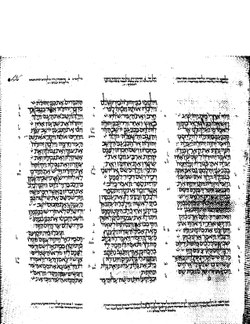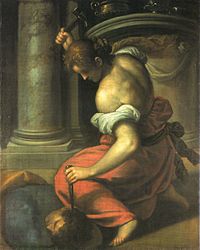Judges 4
| Judges 4 | |
|---|---|
 The pages containing the Book of Judges in Leningrad Codex (1008 CE). | |
| Book | Book of Judges |
| Hebrew Bible part | Nevi'im |
| Order in the Hebrew part | 2 |
| Category | Former Prophets |
| Christian Bible part | Old Testament (Heptateuch) |
| Order in the Christian part | 7 |
Judges 4 is the fourth
Text
This chapter was originally written in the Hebrew language. It is divided into 24 verses.
Textual witnesses
Some early manuscripts containing the text of this chapter in Hebrew are of the Masoretic Text tradition, which includes the Codex Cairensis (895), Aleppo Codex (10th century), and Codex Leningradensis (1008).[7] Fragments containing parts of this chapter in Hebrew were found among the Dead Sea Scrolls including XJudges (XJudg, X6; 50 BCE) with extant verses 5–8.[8][9][10]
Extant ancient manuscripts of a translation into Koine Greek known as the Septuagint (originally was made in the last few centuries BCE) include Codex Vaticanus (B; B; 4th century) and Codex Alexandrinus (A; A; 5th century).[11][a]
Analysis
A linguistic study by Chisholm reveals that the central part in the Book of Judges (Judges 3:7–16:31) can be divided into two panels based on the six refrains that state that the Israelites did evil in Yahweh's eyes:[13]
Panel One
- A 3:7 ויעשו בני ישראל את הרע בעיני יהוה
- And the children of Israel did evil in the sight of the LORD (KJV)[14]
- B 3:12 ויספו בני ישראל לעשות הרע בעיני יהוה
- And the children of Israel did evil again in the sight of the LORD
- B 4:1 ויספו בני ישראל לעשות הרע בעיני יהוה
- And the children of Israel did evil again in the sight of the LORD
Panel Two
- A 6:1 ויעשו בני ישראל הרע בעיני יהוה
- And the children of Israel did evil in the sight of the LORD
- B 10:6 ויספו בני ישראל לעשות הרע בעיני יהוה
- And the children of Israel did evil again in the sight of the LORD
- B 13:1 ויספו בני ישראל לעשות הרע בעיני יהוה
- And the children of Israel did evil again in the sight of the LORD
Furthermore from the linguistic evidence, the verbs used to describe the Lord's response to Israel's sin have chiastic patterns and can be grouped to fit the division above:[15]
Panel One
- 3:8 וימכרם, "and he sold them," from the root מָכַר, makar
- 3:12 ויחזק, "and he strengthened," from the root חָזַק, khazaq
- 4:2 וימכרם, "and he sold them," from the root מָכַר, makar
Panel Two
- 6:1 ויתנם, "and he gave them," from the root נָתַן, nathan
- 10:7 וימכרם, "and he sold them," from the root מָכַר, makar
- 13:1 ויתנם, "and he gave them," from the root נָתַן, nathan
Deborah (4:1–16)
This chapter opens with the conventional narrative pattern of the book, connecting with Ehud without reference to Shamgar (who is later mentioned in Judges 5), to introduce Deborah the prophet as the savior (verse 4), after Israel's formulaic cry to God for relief from oppression.[16]
Deborah delivered military instructions received directly from God to Barak, the apparent leader of Israelite, to confront the army of Jabin, led by Sisera his general, and thereby showing that YHWH is the ultimate military commander in the holy wars fought by his people.[16]
The structure of the section from verses 6–16 is as follows:[17]
- A The command of Deborah and the response of Barak (4:6–9)
- a. Deborah commands Barak to gather an army and assures him of victory (4:6–7)
- b. Barak requires Deborah's presence (4:8)
- c. Barak wins his request but loses glory (4:9)
- B Barak deploys the troops (4:10)
- a. Barak calls (z'q) the troops to Kedesh (4:10a1)
- b. Barak goes up (ʼlh) with the troops (4:10a2–b)
- B' Sisera deploys the troops (4:12–13)
- a. Sisera hears that Barak has gone up (ʼlh) (4:12)
- b. Sisera calls (z'q) the troops to Wadi-Kishon (4:13)
- A' The command of Deborah and the response of Barak (4:14–16)
- a. Deborah commands Barak to go into battle and assures him of victory (4:14a)
- b. Barak goes down to fight (4:14b)
- c. Barak wins the battle but loses Sisera (4:15–16)
In verses 12-16, the pattern of Israel's redemption is completed with the underdogs' victory as prophesied by the prophetess.[16]
Verse 4
- And Deborah, a prophetess, the wife of Lapidoth, she judged Israel at that time.[18]
- "Isaiah 8:3).[16]
- "Wife of
Jael kills Sisera (4:17–24)

The structure of this section is:[19]
Sisera came to Jael's tent (4:17)
- A Jael entreats Sisera to come into her tent (4:18a)
- B Sisera enters asking for aid (4:18b–20)
- C Jael kills Sisera (4:21)
- B Sisera enters asking for aid (4:18b–20)
Barak came to Jael's tent (4:22a1)
- A' Jael entreats Barak to come into her tent (4:22a2)
- B' Barak responds by entering (4:22b1)
- C' Jael presents the slain Sisera to Barak (4:22b2)
- B' Barak responds by entering (4:22b1)
In this section,
The last two verses (23–24) contain a reminder that YHWH controls the battle and gives relief from Israel's oppressors.[21]
Verse 20
- And he said to her, "Stand at the door of the tent, and if any man comes and inquires of you, and says, 'Is there any man here?' you shall say, 'No.' "[22]
The last words of Sisera to Jael (before Sisera was killed by Jael) contain an irony, with the play of the word "any man" (Hebrew ʼiš): the first use refers to the one coming to the tent, which was Barak, whereas the second use refers to the one in the tent, which was Sisera, and the answer should be "No", because Sisera would no longer be alive by the time Barak came.[23][19]
Archaeology

See also
- Abinoam
- Assassination
- Canaan
- Chariot
- Children of Israel
- Goy
- Hazor
- Heber
- Hobab
- Iron
- Kedeshnaphtali
- Kenite
- Kishon River
- Milk
- Mount Ephraim
- Mount Tabor
- Zaanaim
Notes
- ^ The whole book of Judges is missing from the extant Codex Sinaiticus.[12]
References
- ^ Halley 1965, p. 172.
- ^ Talmud, Baba Bathra 14b-15a)
- ^ a b Gilad, Elon. Who Really Wrote the Biblical Books of Kings and the Prophets? Haaretz, June 25, 2015. Summary: The paean to King Josiah and exalted descriptions of the ancient Israelite empires beg the thought that he and his scribes lie behind the Deuteronomistic History.
- ^ Niditch 2007, p. 177.
- ^ Niditch 2007, p. 179.
- ^ Chisholm 2009, pp. 251–252.
- ^ Würthwein 1995, pp. 35–37.
- ^ Ulrich 2010, p. 254.
- ^ Dead sea scrolls - Judges
- ^ Fitzmyer 2008, p. 162.
- ^ Würthwein 1995, pp. 73–74.
- ^
 This article incorporates text from a publication now in the public domain: Herbermann, Charles, ed. (1913). "Codex Sinaiticus". Catholic Encyclopedia. New York: Robert Appleton Company.
This article incorporates text from a publication now in the public domain: Herbermann, Charles, ed. (1913). "Codex Sinaiticus". Catholic Encyclopedia. New York: Robert Appleton Company.
- ^ Chisholm 2009, p. 251.
- ^ Judges 3:7 Hebrew Text Analysis. Biblehub
- ^ Chisholm 2009, p. 252.
- ^ a b c d e Niditch 2007, p. 180.
- ^ Younger 2002, pp. 140, 142.
- ^ Judges 4:4 KJV
- ^ a b c d Younger 2002, p. 144.
- ^ Niditch 2007, pp. 180–181.
- ^ a b c Niditch 2007, p. 181.
- ^ Judges 4:20 NKJV
- ^ Murray, "Narrative Structure and Technique in the Deborah-Barak Story," 180, 183. Schökel, Alonso, "Erzählkunst", p. 166, apud Webb 2012, p.184
- ^ Siegel-Itzkovich, Judy (July 2, 2010). "Long time archaeological riddle solved, Canaanite general was based in Wadi Ara". Jerusalem Post.
- ^ a b "Archaeological Mystery Solved". University of Haifa. July 1, 2010. Archived from the original on July 5, 2010.
- ^ Zertal, Adam (2010) "Sisera's Secret, A Journey following the Sea-Peoples and the Song of Deborah", (Dvir, Tel Aviv)
Sources
- Chisholm, Robert B. Jr. (2009). "The Chronology of the Book of Judges: A Linguistic Clue to Solving a Pesky Problem" (PDF). Journal of the Evangelical Theological Society. 52 (2): 247–55.
- ISBN 978-0-19-528881-0.
- ISBN 978-0-8028-6241-9.
- ISBN 0-310-25720-4.
- Hayes, Christine (2015). Introduction to the Bible. Yale University Press. ISBN 978-0-300-18827-1.
- Niditch, Susan (2007). "10. Judges". In ISBN 978-0-19-927718-6. Retrieved February 6, 2019.
- Ulrich, Eugene, ed. (2010). The Biblical Qumran Scrolls: Transcriptions and Textual Variants. Brill.
- ISBN 978-0-8028-2628-2.
- ISBN 0-8028-0788-7. Retrieved January 26, 2019.
- Younger, K. Lawson (2002). Judges and Ruth. The NIV Application Commentary. Zondervan. ISBN 978-0-310-20636-1.
External links
- Jewish translations:
- Shoftim - Judges - Chapter 4 (Judaica Press). Hebrew text and English translation [with Rashi's commentary] at Chabad.org
- Christian translations:
- Online Bible at GospelHall.org (ESV, KJV, Darby, American Standard Version, Bible in Basic English)
- Judges chapter 4. Bible Gateway

